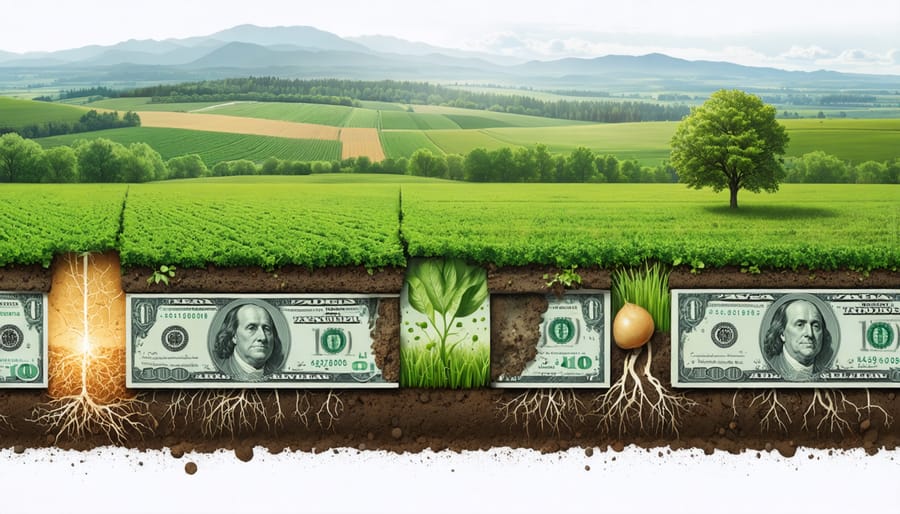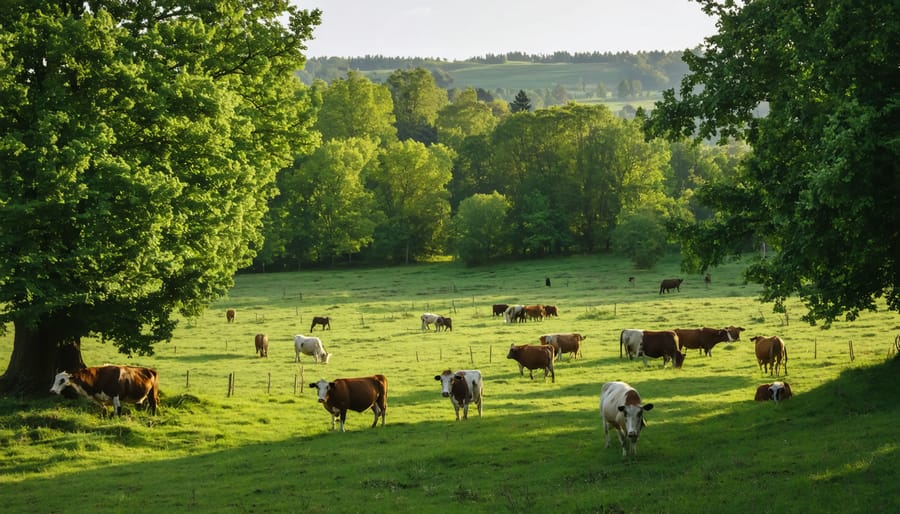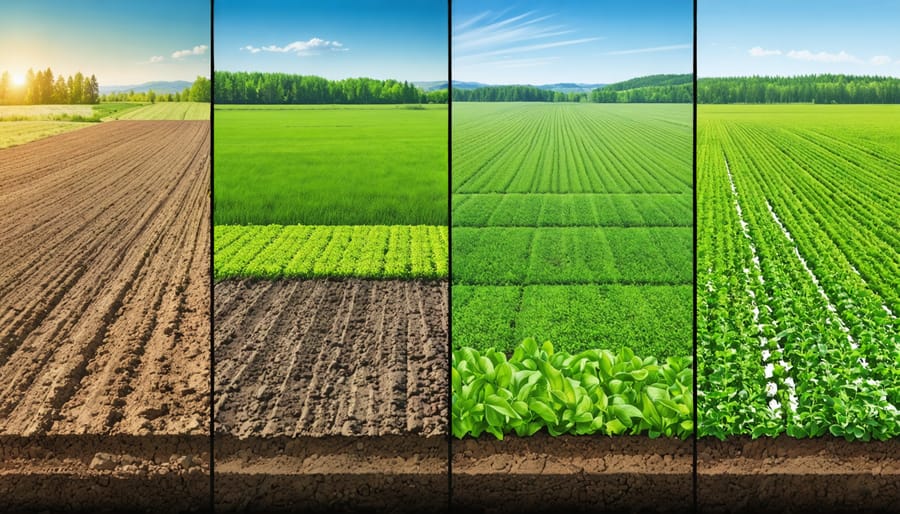Beneath our feet lies one of Earth’s most powerful tools in the fight against climate change. Canadian farmland holds the potential to sequester millions of tonnes of carbon dioxide annually, transforming agricultural practices into a crucial climate solution while creating new revenue streams for farmers. As Alberta’s carbon market matures, understanding soil’s role as a carbon sink has become more than an environmental concern—it’s now a strategic business opportunity worth millions in carbon credits.
Recent soil science reveals that a single hectare of well-managed agricultural land can sequester up to 3.6 tonnes of carbon dioxide equivalent annually. For Alberta’s 50.3 million acres of farmland, this represents a game-changing opportunity to combat climate change while strengthening agricultural communities. Through practices like reduced tillage, cover cropping, and strategic crop rotation, farmers across the province are already proving that profitable agriculture and carbon sequestration can work hand in hand.
The science is clear: soil isn’t just a growing medium—it’s a vast, untapped carbon reservoir waiting to be optimized. As carbon markets evolve and verification methods improve, Alberta’s agricultural sector stands at the forefront of a transformation that promises to reward sustainable stewardship while addressing global climate challenges.
Understanding Soil’s Carbon Storage Potential
The Science Behind Soil Carbon Sequestration
Soil carbon sequestration occurs through a fascinating natural process where plants capture atmospheric CO2 during photosynthesis and transfer carbon into the soil through their root systems. When crop residues and roots decompose, soil microorganisms transform this organic matter into stable soil carbon compounds. These carbon sequestration benefits are enhanced by healthy soil biology and proper management practices.
Several key factors influence how effectively soil stores carbon. Soil texture plays a crucial role, with clay soils typically holding more carbon than sandy soils due to their ability to form stable organic-mineral complexes. Moisture levels, temperature, and oxygen availability also affect microbial activity and carbon storage capacity.
Here in Alberta, our soils have significant potential for carbon storage, particularly in areas with deep, well-structured soil profiles. The cold climate actually works in our favour, as lower temperatures slow down organic matter decomposition, allowing carbon to remain stored longer. Managing soil disturbance, maintaining year-round ground cover, and incorporating diverse crop rotations can help maximize your soil’s natural carbon-storing ability.
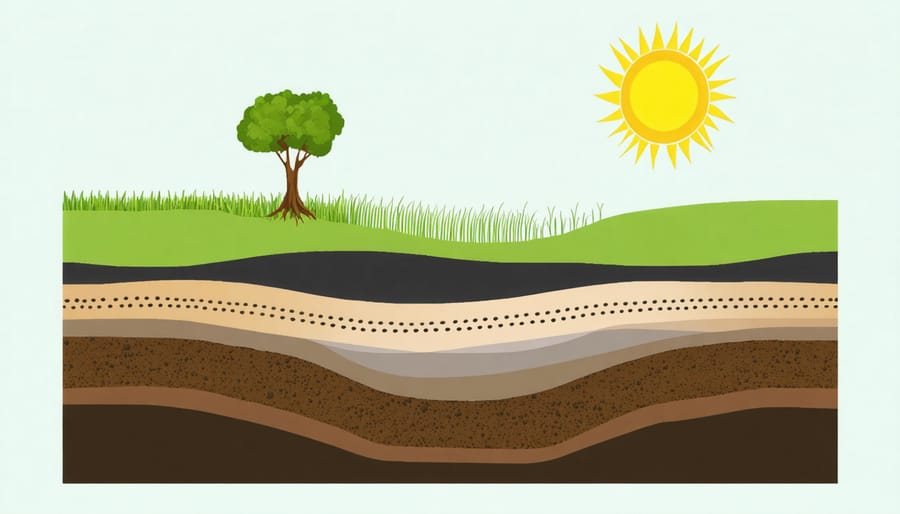
Alberta’s Unique Soil Carbon Potential
Alberta’s unique landscape and diverse soil types position our province as a powerhouse for carbon sequestration. Our prairie soils, particularly the rich Black Chernozemic soils found across central Alberta, naturally hold significant amounts of organic carbon. In fact, these soils can store up to 100 tonnes of carbon per hectare in the top 30 centimetres alone.
What makes Alberta’s soil particularly special is the combination of our cool climate, which slows organic matter decomposition, and our historically grassland-dominated ecosystems, which developed deep, carbon-rich soil profiles over thousands of years. The province’s agricultural zones feature a mix of Brown, Dark Brown, and Black soil zones, each with distinct carbon storage capabilities.
Recent research conducted at the University of Alberta shows that our farmland has the potential to sequester an additional 1 to 3 tonnes of carbon per hectare annually through improved management practices. This represents a remarkable opportunity for Alberta farmers to lead the way in climate-smart agriculture while potentially accessing new revenue streams through carbon offset programs.
Local success stories demonstrate that Alberta farmers are already making significant strides in enhancing their soil’s carbon storage capacity through practices like reduced tillage and cover cropping.
Carbon Credit Opportunities for Alberta Farmers
Available Carbon Credit Programs
Several soil carbon credit opportunities are currently available to Canadian farmers, with Alberta leading the way in program development. The Conservation Cropping Protocol, administered by the Alberta Carbon Offset System, remains one of the most established programs in the country. Farmers can earn credits by implementing qualifying conservation practices such as reduced tillage and continuous cropping.
To participate, farmers must meet specific eligibility criteria, including:
– A minimum of three years of consistent conservation practices
– Detailed record-keeping of farming activities
– Regular soil testing and verification
– Registration with an approved carbon offset registry
The Canada Grassland Protocol offers another pathway for farmers maintaining permanent pasture or converting cropland to grassland. This program typically requires a 30-year commitment to maintain grassland coverage and proper grazing management practices.
Emerging private sector programs are also gaining traction, with companies like Nutrien and Indigo Ag offering additional opportunities. These programs often provide more flexible terms but may require specific data collection methods and technology adoption.
For Alberta farmers, the TIER (Technology Innovation and Emissions Reduction) system provides a provincial framework that supports various carbon credit initiatives, making it easier to participate in multiple programs simultaneously while maintaining compliance with local regulations.
Remember to consult with local agricultural extension offices or carbon program administrators to determine the best fit for your operation, as requirements and benefits can vary significantly between programs.
Payment Structures and Market Rates
The carbon credit market in Alberta currently values soil carbon credits between $15 and $30 per tonne of CO2 equivalent, with rates varying based on verification methods and project scale. Through the Alberta Carbon Offset System, farmers can earn credits for implementing practices that enhance soil carbon storage, such as reduced tillage and cover cropping.
Payment structures typically follow a performance-based model, where farmers receive compensation after demonstrating measurable increases in soil carbon levels. Most programs operate on multi-year contracts, usually spanning 3-5 years, with annual verification requirements. The Alberta Conservation Cropping Protocol, for instance, offers payments based on documented changes in farming practices and subsequent soil carbon improvements.
Local success stories include the Brown family farm near Red Deer, which earned $45,000 in carbon credits over three years by transitioning to no-till practices across 2,000 hectares. Similarly, the Southern Alberta Soil Carbon Coalition reports that participating farms average $20-25 per hectare annually through carbon credit programs.
Emerging market opportunities include private sector partnerships, where food companies are increasingly offering premium prices for crops grown using carbon-storing practices. These arrangements often provide upfront funding for practice changes and additional bonuses for verified carbon storage, making the transition more financially viable for farmers.
Remember that market rates are dynamic and tend to increase as carbon markets mature and demand grows. Working with local agricultural extension offices can help identify the most current and profitable programs available.
Implementing Soil Carbon Management Practices

No-Till Agriculture Techniques
In Alberta’s challenging climate, implementing effective no-till farming practices requires careful planning and adaptation to local conditions. The key to success lies in maintaining crop residue on the field surface, which protects soil from erosion during our strong prairie winds and helps retain moisture during dry spells.
For spring seeding, timing is crucial. Wait until soil temperatures reach at least 5°C at seeding depth, typically in early May for most regions. Using proper equipment is essential – invest in seeders with disc openers that can effectively cut through residue without disturbing the soil structure. Many Alberta farmers have found success with parallel linkage drills that maintain consistent seeding depth.
Managing residue throughout the season is vital. Consider using stripper headers during harvest to leave longer stubble standing, which better catches snow and reduces spring moisture loss. For heavy residue situations, use precision spreaders to ensure even distribution across your fields.
Cover crops adapted to our shorter growing season, such as fall rye or winter wheat, can provide additional soil protection and organic matter input. In areas prone to spring flooding, consider adding channels for excess water management while maintaining minimal soil disturbance.
Remember to monitor soil compaction and address it through controlled traffic patterns rather than tillage. Many successful Alberta farmers use GPS guidance systems to maintain consistent traffic patterns year after year.
Cover Crop Selection and Management
Selecting the right cover crops is crucial for maximizing soil carbon sequestration in Alberta’s diverse growing conditions. For early spring or late fall planting, cold-hardy options like fall rye and winter wheat work exceptionally well in our climate. During the main growing season, deep-rooted crops such as alfalfa and red clover are excellent choices for driving carbon deeper into the soil profile.
Consider mixing different cover crop species to create a diverse root system architecture. A popular combination among Alberta farmers includes cereals like oats or barley with legumes such as field peas or hairy vetch. This approach not only enhances carbon storage but also improves soil structure and nutrient cycling.
Timing is everything when managing cover crops for carbon sequestration. Plant your cover crops immediately after harvesting your main crop to maximize growing days. In our region, aim to establish them by mid-August for optimal results. When terminating cover crops, consider rolling or crimping rather than chemical termination to keep the carbon locked in the soil.
For best results, maintain living roots in the soil as long as possible throughout the year. Some Alberta farmers have success with relay cropping, where they seed cover crops into standing cash crops before harvest. This technique extends the growing season and increases the potential for carbon capture.
Remember to monitor soil moisture levels, as cover crops can impact water availability for subsequent cash crops. Adjust your management practices based on seasonal conditions and your specific soil type.
Crop Rotation Strategies
Here in Alberta, smart crop rotation is one of our most powerful tools for building soil carbon. Local farmers have found success with three to four-year rotation cycles that combine deep-rooted perennials with annual crops. A particularly effective sequence starts with canola, followed by wheat, then introduces a pulse crop like field peas, and finally incorporates a cover crop season.
Including legumes in your rotation does double duty – they fix nitrogen in the soil while adding organic matter. Many Alberta farmers report success with alfalfa or clover as part of their rotation, as these crops develop extensive root systems that contribute significantly to soil carbon levels.
To maximize carbon storage, consider these proven strategies:
– Alternate between shallow and deep-rooted crops
– Include at least one season of nitrogen-fixing legumes
– Add cover crops during shoulder seasons
– Minimize fallow periods
– Incorporate perennial forages when possible
The timing of your rotations matters too. Fall-seeded crops like winter wheat can extend the growing season and increase carbon capture potential. Local research shows that fields using diverse rotation patterns store up to 25% more carbon compared to continuous cropping systems.
Remember to adjust your rotation plan based on your specific soil type and local climate conditions. What works in southern Alberta may need tweaking for central or northern regions.
Measuring and Verifying Soil Carbon Levels
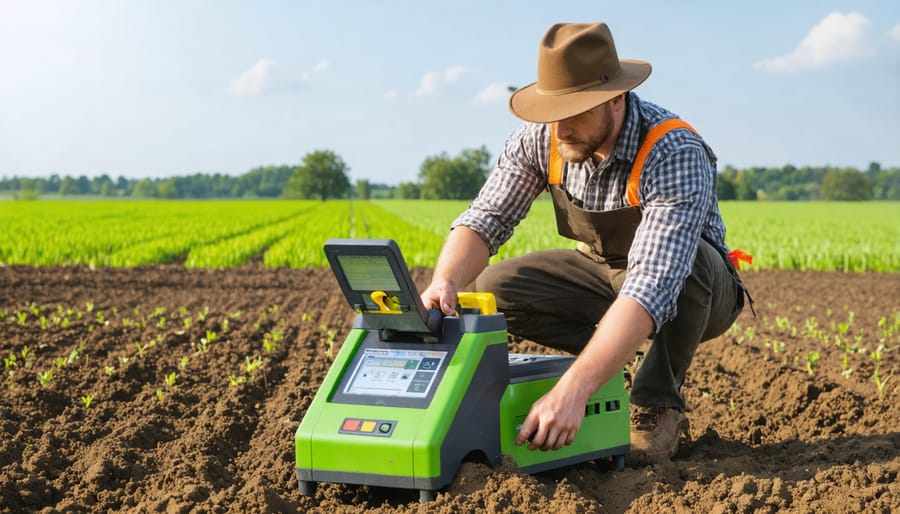
Soil Testing Methods
Modern soil testing methods offer farmers reliable ways to measure carbon levels and track storage progress. The most common approach is laboratory analysis, where soil samples are collected from various depths and locations across the field. These samples undergo detailed testing to determine carbon content, typically measured in tonnes per hectare.
Field-based methods are gaining popularity among Alberta farmers due to their convenience. Portable carbon analyzers provide quick results, though they’re often used alongside lab testing for verification. Visual soil assessment techniques, while less precise, help farmers monitor changes in soil organic matter management through indicators like soil structure and color.
Remote sensing technology is emerging as a promising tool, using satellite imagery and spectral analysis to assess soil carbon levels across large areas. Many Alberta carbon programs now accept a combination of these methods, requiring initial baseline measurements followed by periodic testing to verify carbon sequestration progress. This multi-method approach ensures both accuracy and practical feasibility for farmers participating in carbon markets.
Documentation Requirements
Proper documentation is essential for verifying soil carbon storage and accessing carbon credit markets. Keep detailed records of your soil management practices, including dates of implementation, specific techniques used, and areas covered. Take regular soil samples, ideally every 2-3 years, and maintain a consistent sampling protocol across your fields.
Document your baseline carbon levels through initial comprehensive soil testing, and store these results safely. Track all inputs, including fertilizer applications, crop rotations, and tillage practices. Photos of field conditions and management activities can serve as valuable supporting evidence.
For Alberta farmers, the Conservation Cropping Protocol requires maintaining records for a minimum of seven years. Essential documents include field maps, equipment logs, and yearly cropping plans. Digital record-keeping systems can simplify this process – many farmers use smartphone apps or farm management software to track their data.
Consider working with a qualified agrologist to ensure your documentation meets provincial standards. They can help establish a robust monitoring system that aligns with carbon credit program requirements while keeping the process manageable for your operation.
Soil carbon sequestration presents a significant opportunity for Canadian farmers to contribute to climate change mitigation while potentially creating new revenue streams. As we’ve explored throughout this article, healthy soil management practices not only increase carbon storage but also improve farm productivity and resilience.
For Alberta farmers interested in participating in soil carbon financing programs, the path forward is clear. Start by conducting baseline soil testing and documenting current practices. Consider implementing proven carbon-building techniques such as reduced tillage, cover cropping, and diverse crop rotations. Connect with local agricultural extension services and carbon program providers to understand available opportunities in your region.
Remember that success in soil carbon programs requires patience and consistent implementation. While the carbon market is still evolving, early adopters are positioning themselves advantageously for future opportunities. The key is to focus on practices that benefit both your soil health and farm operations, ensuring that carbon revenue becomes an additional benefit rather than the sole motivation.
Take the next step by reaching out to fellow farmers who are already participating in carbon programs, attending workshops, and consulting with soil health specialists. The Alberta agriculture community has a strong history of innovation and adaptation – soil carbon management is the next frontier in sustainable farming practices. By acting now, you’re not just investing in your soil’s health; you’re building a more resilient and profitable agricultural future.

